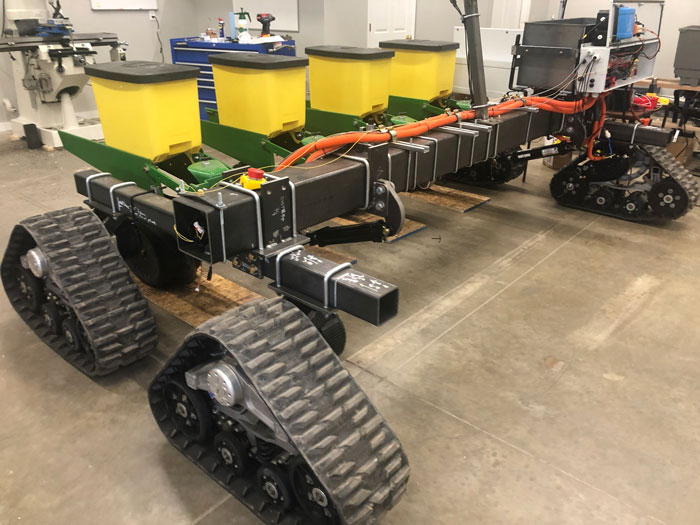With a lifetime of farming experience and degrees in agronomy and economics, Dave Krog says he’s trying to whittle variable and fixed costs from today’s equipment outlays with an electric, autonomous drive unit aimed squarely at the 24-row planter.
“Our goal is to make this kind of solution less expensive than today’s technology,” Krog says. “By eliminating the tractor and the heavy sprayer, we can leverage our running gear and chassis over many operations.”
Doing business as Salin 247, in Ames, Iowa, Krog and his engineer son ran their first two-track-drive prototype robot in Iowa in 2021, and plan to have the second, upgraded version of the machine planting soybeans and corn in Iowa and Tennessee this spring.
The 2022 test version consists of 4 individually-powered electrically-driven track units mounted on the corners of a rectangular steel tool-bar frame. The drive unit carries a 48 Volt, 100-amp (10 kWh) lithium iron-phosphate battery pack along with RTK GPS navigation equipment and 2020 Precision Planting equipment and software. The machine uses cameras and computer vision for safety and obstacle detection. Plus, the Krogs are also testing on-board radar technology.
The 4-row prototype is designed to plant at 5.5 mph, and carry spray and side-dress capabilities up to 10 mph.
“We could put speed tubes on for planting, but we want to prove our design at slower speeds first,” Krog explains. “For post-emergence work our unit is slower than the big rigs, but we foresee a time when several of our drive units could be doing the job of the larger machines at less cost — and because they are lighter, and equipped with machine vision, they can get in the field quicker after a rain and work in all light conditions.”

Salin 247’s 2022 prototype autonomous electric-drive unit, prepared for planting, features the ability to switch hit between planting, spraying and side-dressing with a lighter footprint and improved cost-effectiveness over traditional pull-behind equipment.
The prototype weighs 1,400 pounds (4,000 with planting units attached) and current plans are for the robot to carry 200 gallons of liquid for spraying chores.
Going to the field as a planter in 2022, the Krogs’ drive unit will be capable of running about 90 minutes of continuous operation before a battery swap is necessary.
“We don’t want a planter or sprayer to sit and wait on charging, so we plan to have two batteries in rotation (one working the other on a charger) and ultimately an automatic docking/charging station,” Krog explains. “We don’t have the charging station perfected yet, so for our tests this year we’ll be on-hand to swap the batteries.”
Currently the charging station is powered by an 8.5 kW B100 bio-diesel generator, and Krog says it will charge a battery in the same time its counterpart is being discharged on the planter.
Krog says Salin 247 is working on 4, 6, 7 and 8-row configurations for its drive units and would like to concentrate on 6- and 8-row units to be economically feasible and competitive against today’s familiar tractor-pulled 24-row planter.
“When the time comes for commercialization, pricing will be based against new-and-used 24-row planter prices as a baseline,” Krog explains. “Also, we’ll be allocating some of the tractor costs we’re eliminating into our formulas, but we definitely want to be under the baseline of new traditional equipment.
“Our drive unit can be used across operations to bring costs down,” he says. “That’s how we’ll be pricing any products we bring to market.”
Krog says current estimates indicate a grower could reduce fixed costs on machinery using the integrated drive units by 25-35% or more, but for operational costs (fuel, maintenance, labor and repair) the savings could be as high as 50%.
“Based on a dollar-per-acre energy cost, when looking at an average 10-cent per kilowatt price for electricity and the cost per gallon of diesel fuel, energy costs for planting could be cut by 75% with our electric propulsion,” he says.
Krog says, while his test units require battery swaps and less-than-optimum run times, battery and charging technology are continually improving in price and capacity. Also, rural access to on-farm renewable energy generation is becoming more commonplace which will enable improved access to in-field battery maintenance in the not-too-distant future.
Salin 247 foresees a time when several lighter-weight drive units, outfitted for different field operations, could replace traditional heavy, high-horsepower tractors pulling heavy, wide, broad-acre implements — reducing soil erosion and amortizing their cost with time and energy-saving efficiencies.
“If you’re running four 6-row robot planters and one hits a rock, you still have 18-rows of planting active in the field,” Krog explains. “If you hit that rock with a 24-row planter, the entire machine is down until it’s repaired.
“Ultimately, we’d like to see our technology working at harvest time too, but that’s a long way off,” Krog says. “Right now, we want to perfect our technology to work in all terrains with practical run and charging times.
“Battery technology is where we get the most pushback on our concept,” he says. “It’s new and field tests will be necessary to get it out in front of farmers. The technology is rapidly improving as the automotive industry spends billions on it, so batteries are going to keep getting better.”







Post a comment
Report Abusive Comment